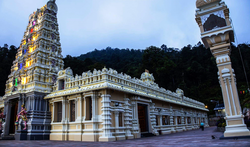
Back الهندوسية في ماليزيا Arabic মালয়েশিয়ায় হিন্দুধর্ম Bengali/Bangla मलेशिया में हिंदू धर्म Hindi Hinduisme di Malaysia ID Induismo in Malaysia Italian Hinduisme di Malaysia Malay मलेसियामा हिन्दु धर्म Nepali ਮਲੇਸ਼ੀਆ ਵਿਚ ਹਿੰਦੂ ਧਰਮ Punjabi ملائشیا وچ ہندو دھرم PNB Индуизм в Малайзии Russian
 | |
 | |
| Total population | |
|---|---|
| 1.97 million (2020 est.) 1.79 million (2011 census) | |
| Religions | |
| Hinduism | |
| Languages | |
| Liturgical Old Tamil and Sanskrit Predominant Tamil Minority Telugu, Malayalam, Nepali, Bengali, Balinese, Chinese, Iban, Chitty Malay National language Bahasa Malaysia |
| Hinduism by country |
|---|
  |
| Full list |

Hinduism is the fourth-largest religion in Malaysia. About 1.97 million Malaysian residents (6.1% of the total population) are Hindus, according to 2020 Census of Malaysia.[2] This is up from 1.78 million (6.3% of the total population) in 2010.[3]
Most Malaysian Hindus are settled in western parts of Peninsular Malaysia. There are 3 states in Malaysia that qualify to be a Hindu enclave, where the Hindu percentage is greater than 10% of the population. The Malaysian state with highest percentage of Hindus, according to 2010 Census, is Negeri Sembilan (13.4%), followed by Selangor (11.6%), Perak (10.9%) and Federal Territory of Kuala Lumpur (8.5%).[4] The first three mentioned technically count as being Hindu enclaves. The state with the least percentage of Hindu population is Sabah (0.1%).
Indians, along with other ethnic groups such as Chinese, began arriving in Malaysia in the ancient and medieval era. In 2010, Malaysian Census reported there were 1.91 million citizens of Indian ethnic origin.[5] About 1.64 million of Indian ethnic group Malaysians (86%) are Hindus. About 0.14 million non-Indian ethnic group Malaysian people also profess being Hindus.[6]
Malaysia gained its independence from the British colonial empire in 1957, thereafter declared its official state religion as Islam, and adopted a constitution that is mixed. On one hand, it protects freedom of religion (such as the practice of Hinduism), but on the other hand Malaysian constitution also restricts religious freedom.[7][8][9] In recent decades, there have been increasing reports of religious persecution of Hindus, along with other minority religions, by various state governments of Malaysia and its Sharia courts.[7][10] Hindu temples built on private property, and built long before Malaysian independence, have been demolished by Malaysian government officials in recent years.[11]
- ^ "Malaysia Demographics Profile". 27 November 2020.
- ^ 2010 Population and Housing Census of Malaysia (Census 2010) Archived 14 September 2014 at the Wayback Machine Department of Statistics Malaysia, Official Portal (2012)
- ^ Saw, Swee-Hock (2007). The Population of Malaysia. Institute of Southeast Asian Studies. ISBN 9789812304438.
- ^ Population Distribution and Basic Demographic Characteristics 2010 Archived 11 October 2012 at the Wayback Machine Department of Statistics, Government of Malaysia (2011), Page 13
- ^ "Population Distribution and Basic Demographic Characteristics 2010" (PDF). Department of Statistics. Government of Malaysia. 2011. p. 15. Archived from the original (PDF) on 11 October 2012.
- ^ Population Distribution and Basic Demographic Characteristics 2010 Archived 11 October 2012 at the Wayback Machine Department of Statistics, Government of Malaysia (2011), Page 82
- ^ a b Refugees, United Nations High Commissioner for. "Refworld | 2011 Report on International Religious Freedom – Malaysia". Refworld. Retrieved 10 June 2021.
- ^ Gill, Savinder Kaur; Gopal, Nirmala Devi (1 October 2010). "Understanding Indian Religious Practice in Malaysia". Journal of Social Sciences. 25 (1–3): 135–146. doi:10.1080/09718923.2010.11892872. ISSN 0971-8923. S2CID 30276441.
- ^ Raymond Lee, Patterns of Religious Tension in Malaysia, Asian Survey, Vol. 28, No. 4 (Apr., 1988), pp. 400-418
- ^ Religious Freedom Report 2013 – Malaysia U.S. State Department (2014)
- ^ Religious Freedom Report 2012 – Malaysia U.S. State Department (2013)